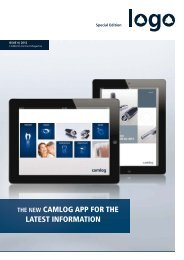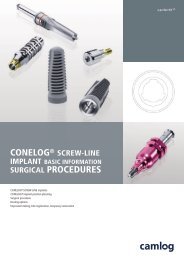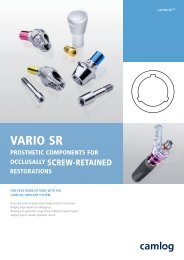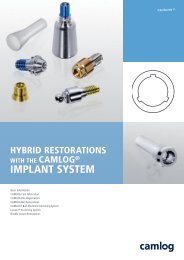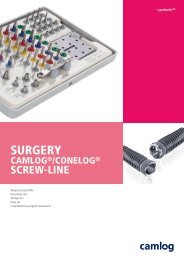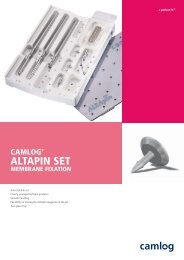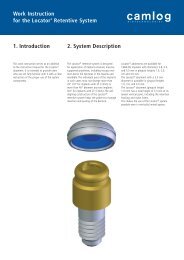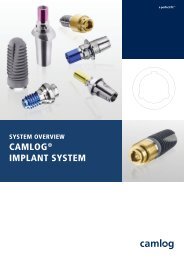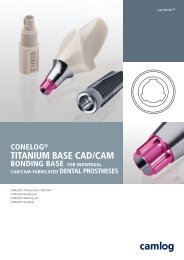CONELOG® Implant System Prosthetic Restorations - Camlog
CONELOG® Implant System Prosthetic Restorations - Camlog
CONELOG® Implant System Prosthetic Restorations - Camlog
Create successful ePaper yourself
Turn your PDF publications into a flip-book with our unique Google optimized e-Paper software.
CAUTION!<br />
Do not cover the fine gold margin (0.1 mm) with wax. This can lead to a<br />
surplus of cast-on alloy on the conical surface of the implant abutment<br />
connection and ruin the precise fit.<br />
After the wax-up is finished, a suitable agent must be used to clean the fine<br />
gold margin and the conical surface of the implant abutment connection of<br />
separating medium and wax particles (e.g. with a cotton swab soaked in<br />
alcohol).<br />
EMBEDDING AND CASTING<br />
The abutment is embedded according to the instruction manual of the muffle<br />
system used. We do not recommend the use of wax wetting agents. The<br />
fine film from the agent can lead to a surplus of cast-on alloy on the margin<br />
or on the conical surface of the implant abutment connection. When embedding,<br />
the correct placement of the wax-up in the casting muffle is of importance.<br />
Volume ratios and pin angles must be selected so that the required<br />
temperature for formation of a metallic connection is achieved. This<br />
is particularly important for voluminous casts.<br />
The investment material must be matched with the cast-on alloy and the<br />
casting alloy used. We recommend phosphate bound investment materials.<br />
The manufacturer›s processing instructions must be observed and the mixing<br />
ratios and preheating times accurately observed. We recommend you<br />
do not use any quick heating processes (speed investment materials). The<br />
cast delay time must be kept as brief as possible.<br />
0.1 mm gold margin<br />
Conical implant abutment<br />
connection<br />
CONELOG ® groove/cam<br />
design<br />
CONELOG ® IMPLANT SYSTEM<br />
PROSTHETIC RESTORATIONS<br />
INSTRUCTIONS FOR THE CAST-ON ALLOYS<br />
The cast-on alloy may not exceed the liquidus temperature of 1350°C<br />
(2462°F) in its melting range. The melting range of the high-melting cast-on<br />
gold alloy lies between 1400°C–1490°C (2552°F–2714°F). The cast-on alloy<br />
must be highly gold-bearing in its components and be compatible with the<br />
high-melting cast-on gold alloy. Observe the instructions of the alloy manufacturer.<br />
The use of other cast-on alloys is not recommended.<br />
Components of an unsuitable alloy can lead to phases with reduced corrosion<br />
resistance, less stability or a low melting range thanks to «diffusion processes»<br />
in the border zone «casting alloy/cast-on alloy».<br />
59



